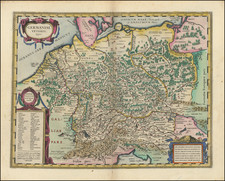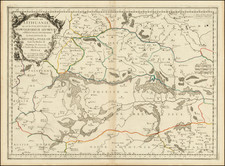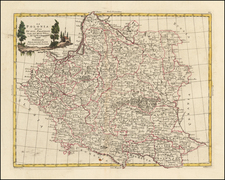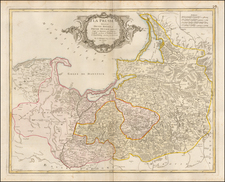Prussia Loses Northern Poland after the Treaties of Tilsit -- From the Collection of General Nicolas Oudinot
Rare map of Northern Poland, etc., published by Simon Schropp & Co. immediately following the signing of the Treaty of Tilsit in 1807.
The title of the map translates as follows:
Country boundary between the Kingdom of Prussia and the Duchy of Warsaw, according to the convention concluded on the 10th of November, 1807, according to the Tilsite peace treaty of July 9, 1807, to Elbing, and the local delimitation made in 1808, designed v FB Engelhardt.
The map was issued shortly after the Treaties of Tilsit wherein almost all that Prussia had gained by the partitions of Poland (1772-1795) was taken from it by France and its allies.
The Treaties of Tilsit were signed by Napoleon I of France in the town of Tilsit in July 1807, in the aftermath of his victory at Friedland. The first was signed on July 7, between Tsar Alexander I of Russia and Napoleon I of France, when they met on a raft in the middle of the Neman River. The second was signed with Prussia on July 9. The treaties were made at the expense of the Prussian king, who had already agreed to a truce on June 25 after the French Army had pursued him to the easternmost frontier of his realm. In Tilsit, he ceded about half of his pre-war territories. Napoleon created French sister republics, which were formalized and recognized at Tilsit: the Kingdom of Westphalia, the Duchy of Warsaw and the Free City of Danzig. The other ceded territories were awarded to existing French client states and to Russia.
The map shows the boundary between the French controlled Kingdom of Prussia and the Duchy of Warsaw, with the map extending from Drezdenko to Działdowo
Following the Treaty, Napoleon would expand his territorial holdings to include all of Poland, with the Poles hoping to re-establish their Kingdom. However, after Napoleon's loss in Russia in 1812, the Duchy of Warsaw was retaken by Russia in January 1813, with the rest of Poland restored to Prussia.
Rarity
The map is very rare. OCLC locates 2 copies (Sächsische Landesbibliothek - Staats- und Universitätsbibliothek Dresden and Bayerische Staatsbibliothek).
General Nicolas Charles Oudinot
A final detail that gives this map particular importance is the identity of its former owner, Nicolas Charles Oudinot, 1st Comte Oudinot, 1st Duc de Reggio (1767 - 1848), and a Marshal of France. A fierce fighter, the man was wounded no less than 34 times during his military career!
The only one of nine siblings to live past childhood, Oudinot joined the army without a noble pedigree, and therefore without a chance of high promotion. That all changed in 1792, with the outbreak of the French Revolution. In that year, Oudinot was elected lieutenant-colonel of the third battalion of the volunteers of the Meuse. After transfer to the regular army and admirable service in Belgium, he was promoted to the rank of general in June 1794 after the Battle of Kaiserslautern.
From Belgium he shifted to the German and Swiss fronts, where he fought as a general of division and chief of staff to Andre Massena. Oudinot stood out at the Battle of Monzambano so much so that Napoleon himself presented him with a sword of honor, now known as the Legion d'Honneur. Napoleon did not forget him after he established his empire; now Emperor Napoleon recognized Oudinot again, this time with a Grand Cross of the Legion of Honor.
During the Napoleonic Wars, Oudinot continued to acquit himself commendably. He was elected a member of the Chamber of Deputies, commanded a company of grenadiers nicknamed for him, and fought in battles from Vienna to Poland. In 1808, he was appointed governor of Erfurt and was made a Count of the French Empire. Finally, in 1809, after the Battle of Wagram, he was named a Marshal of France, France's highest military distinction.
Oudinot continued to serve as an administrator in Holland and on the battlefield in the Russian campaign. After Napoleon's fall, Oudinot joined the Bourbon Restoration and stayed loyal to the King even after Napoleon's return in 1815. For his loyalty and service, he was named a peer of the realm. He served until 1823, when he participated in the French invasion of Spain. Then, he turned again to political and administrative appointments; he died while serving as governor of Les Invalides, at the veterans' hospital in Paris.
Provenance
Purchased at auction in Paris, from Artcuriel, Collections from the Castle of Malicorne Marshal Oudinot's Historical Souvenirs, June 13, 2017 (Lot 156).

![[ Marshal Oudinot Copy ] Landes-Grenze zwischen dem Königreich Preussen und dem Herzogthum Warschau nach der am 10ten November 1807, dem Tilsiter Friedens Tractat vom 9ten Juli 1807 gemäss, zu Elbing abgeschlossenen Convention und der im Jahre 1808 darauf erfolgten örtlichen Begrenzung, als Supplement, der von Schröttersche By Friedrich Bernhard Engelhardt](https://storage.googleapis.com/raremaps/img/small/99041.jpg)













![[Poland, Croatia, Slovenia, Hungary, Serbia, Romania, Ukraine, Bulgaria] (La discrittione della Transylvania et parte del l'Ungaria, et il simil della Romania)](https://storage.googleapis.com/raremaps/img/small/59225.jpg)

![(Second World War - Holocaust) Getta na ziemiach w okresie okupacji Hitlerowskiej w latach 1939-1945 | Hitlerowskie obozy prezjsciowe na ziemiach Polskich w latach 1939-1945 [Ghettos on the lands during the Nazi occupation in 1939-1945 | Nazi presiding camps in Poland in 1939-1945]](https://storage.googleapis.com/raremaps/img/small/82907.jpg)